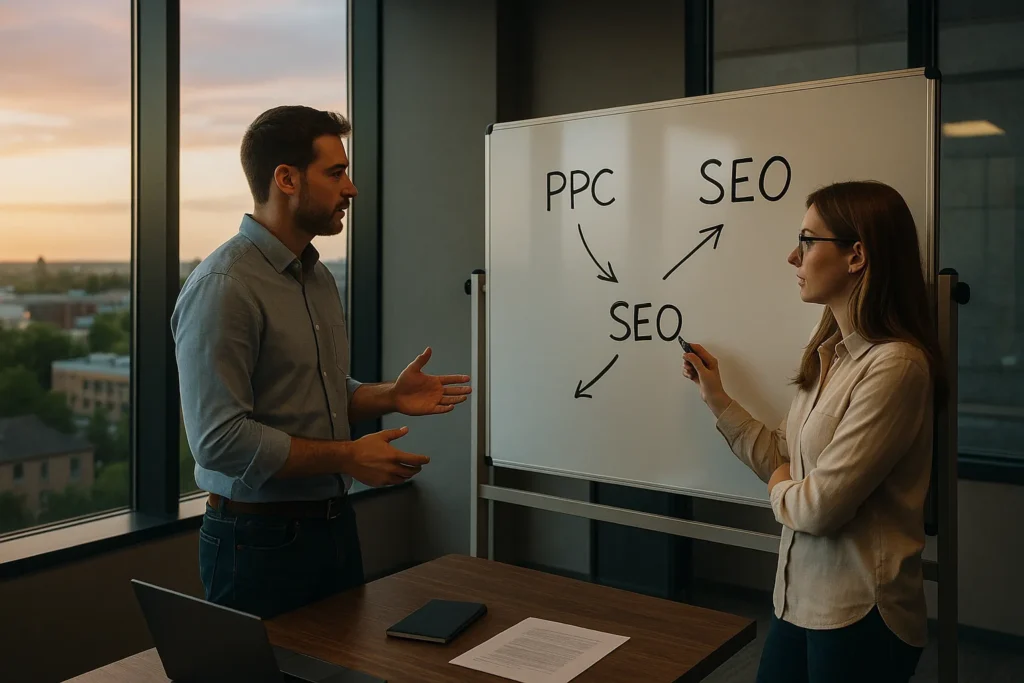
How to Align PPC with SEO for a Unified Search Strategy
Welcome to Oikos Project. We're here today to solve one of digital marketing's biggest puzzles: why so many businesses throw money at Google ads and SEO like they're playing two different games.
The truth is, most companies treat their digital marketing strategy as if paid ads and organic rankings live in separate worlds. But here's what we've learned after 10 years in this business: there's a better way.
In this guide, you'll discover how to stop fighting yourself and start making these approaches work together. When you do this right, you'll create a powerhouse strategy that dominates search results from top to bottom.
Ready to turn your scattered efforts into a strategy that actually makes sense? Let's get started.
Building Your Foundational PPC and SEO Strategy
Before diving into tactics of PPC and SEO, let's establish the groundwork that makes everything else possible.
How Google Ads Data Reveals Hidden SEO Opportunities
We see this mistake all the time. Most businesses completely miss how their Google Ad campaigns are already collecting valuable SEO data. The truth is, this data can improve your search strategy efficiently.
Take our client's plumbing company. They targeted "plumbing services" everywhere. Why? It had high search volume. But their Google ads showed something different. "Emergency leak repair" converted three times better.
We changed their SEO focus to emergency keywords. And fortunately, their organic traffic from real customers doubled in four months.

Finding Keywords That Work for Both Strategies
Here's what we've discovered: recent industry research shows 76% overlap between top PPC and SEO keywords. This means you're probably targeting the right terms already. The problem is you treat them like separate things instead of teammates.
We recommend using Google Keyword Planner as your single research tool for both strategies. Instead of running separate keyword research for each approach, focus on finding terms that work for both paid search and organic rankings.
Turning PPC Campaigns Into SEO Success
Your current PPC data is sitting on insights that most competitors never discover.
We see this problem everywhere. Only 10% of marketing professionals identify PPC as a primary focus for their budget allocation, showing the disconnect between channels. Most businesses run their PPC campaigns and SEO like they're totally different things.
Here are four ways your Google ads data can boost your SEO results:
- Search term reports reveal long-tail organic opportunities: Your ads show you exactly what people type when they're ready to buy. The best part is these real search terms often convert better than the broad keywords you originally targeted. That's because they capture actual buying intent.
- Ad copy with high click rates becomes a meta description template: When certain headlines get people clicking on your ads, you've found winning language. The next step is using similar words in your organic search results. Test your best ad copy as page titles and descriptions to improve your click rates there, too.
- Landing page heat maps show user behavior for SEO optimization: Here's where it gets interesting. When you see where visitors click and scroll on your paid traffic pages, you learn what content actually works. Then you can apply these insights to improve all your website pages, not just the paid ones.
- Geographic performance data guides local SEO focus: Your ads tell you which cities and regions convert best. Instead of guessing where to focus, use this data to prioritize your local search efforts on these profitable areas first.
Take this e-commerce store we worked with. They found "waterproof hiking boots women" buried in their search terms report. This phrase had low search volume but high conversions. We built SEO content around it, and they ranked organically within three months.
Creating Landing Pages That Dominate Search Results
Creating landing pages that satisfy quality score requirements while climbing search engine results pages sounds complicated. But it's simpler than most people think. The main problem is that businesses optimize for one channel and completely ignore the other. This creates missed opportunities everywhere.
Here's what we've learned: both Google's algorithm and your potential customers want the same things from your content. Quality score factors like page speed directly overlap with organic search ranking signals.
What's more, fast loading helps both your ads and SEO performance. Similarly, clear headlines attract clicks from both paid and organic listings. What’s more, the useful content satisfies search engines and real visitors at the same time.
Our suggestion is simple: build pages that work for both strategies from the start. Focus on fast loading times, clear answers to user questions, and the right keywords for your target audience.
When your landing pages check these boxes, they convert better from ads and rank higher organically. You get double the results from the same effort.
Reaching Potential Customers at Every Stage
The table below shows how your customers think at each stage of buying. It also shows what PPC and SEO should do at each step. Most importantly, it reveals the combined impact when both channels work together.
|
Search Stage |
PPC Approach |
SEO Approach |
Combined Impact |
|
Awareness |
Broad match keywords, discovery campaigns |
Blog posts, how-to guides |
3x higher brand recall |
|
Consideration |
Specific product terms, comparison ads |
Product comparison pages |
45% faster decision-making |
|
Decision |
Branded keywords, urgent action ads |
Testimonial pages, pricing info |
2x conversion rate |
Let's explain the table to you.
When someone first realizes they have a problem, they're usually not ready to whip out their credit card just yet. Your Google ads with broad keywords are there to catch their eye during those early "hmm, I wonder if there's a solution for this" moments.

Meanwhile, your SEO content becomes their helpful guide, walking them through possible solutions. This one-two punch builds trust way faster than putting all your eggs in one basket.
Once they move into the "okay, now I'm seriously looking" phase, people start shopping around and comparing what's out there. They know what their problem is and want to find the perfect fix. That's when your specific product ads step in to show them exactly what you've got.
However, your comparison content helps them understand why you're better. Google's consumer behavior research proves that customers who see both paid and organic results trust brands more.
In the decision stage, people are ready to buy but need that final push. Your branded search ads capture immediate buying intent. Your testimonial pages provide social proof through organic search results. When someone sees your brand dominating both areas, it signals authority and reliability.
Our tests show that businesses using this coordinated digital marketing strategy see 67% better ROI than single-channel approaches. That’s undoubtedly impressive!
Measuring Success Across Your Unified Strategy
How do you measure success when combining PPC and SEO? The answer isn't what most people expect.
Here's the problem with traditional measurement that we've seen in our experience. Most businesses track search engine optimization and paid search advertising separately. This means they miss the bigger picture of how these channels boost each other. Standard reports don't show the real story of integrated performance.

That's why you need these three measurement approaches that reveal the true impact of your integrated strategy:
- Share of Voice: This combines organic and paid visibility for your most important keywords. This metric tells you how much of the search engine results you actually control. Rather than looking at rankings and ad positions as different things, you see your complete presence. A higher share of voice means both strategies are supporting each other properly.
- Customer Lifetime Value: This compares integrated visitors against single-channel traffic. The visitors who see you in both organic search results and ads tend to be more valuable. They convert better and spend more because seeing you everywhere builds trust. Track these differences to prove the value of your combined approach.
- Attribution Modeling: This shows which channel combinations create the best results. Google Analytics 4 cross-channel reports can help with this. However, many agencies overlook simple tracking methods that work just as well. For instance, try measuring how your organic traffic changes when you run branded ads. This lift effect proves how your channels work together.
Quick Answers to Common Integration Questions
These three questions come up in nearly every strategy session with our clients:
Q: Should I pause PPC ads for keywords I rank #1 organically?
No, our research shows 89% incremental clicks when running both. When people see your brand in both paid and organic search results, they're more likely to click. Your ad also protects against competitors who might bid on your branded terms. Even when you rank first organically, your pay-per-click ad gives you extra visibility.
Q: How much budget should I split between paid and organic?
Start 70/30 paid/organic, adjust based on industry competition. High-competition industries need more ad spend to compete. Lower competition areas can focus more on SEO. Test this ratio for three months, then shift based on which channel brings better results for your business.
Q: What's the biggest mistake businesses make when combining these?
Competing against themselves with misaligned messaging. Your ppc ads and organic content should tell the same story. If your ad promises one thing but your landing page says something else, people get confused. Keep your messaging consistent across both search engine results pages.
Taking Your Search Marketing to the Next Level
You now have the complete roadmap for turning your scattered search engine marketing efforts into one powerful strategy. Instead of letting your PPC and SEO campaigns compete against each other, you can make them work as a team that dominates search results.
The businesses that implement this unified digital strategy see real results fast. They capture more qualified traffic, convert more visitors, and spend their marketing budget more wisely. At Oikos Project, our Google AdWords and PPC campaign services are built around this integrated approach.
Ready to stop wasting money on disconnected campaigns? Contact us today and let's build a search engine strategy that truly makes sense for your business.



